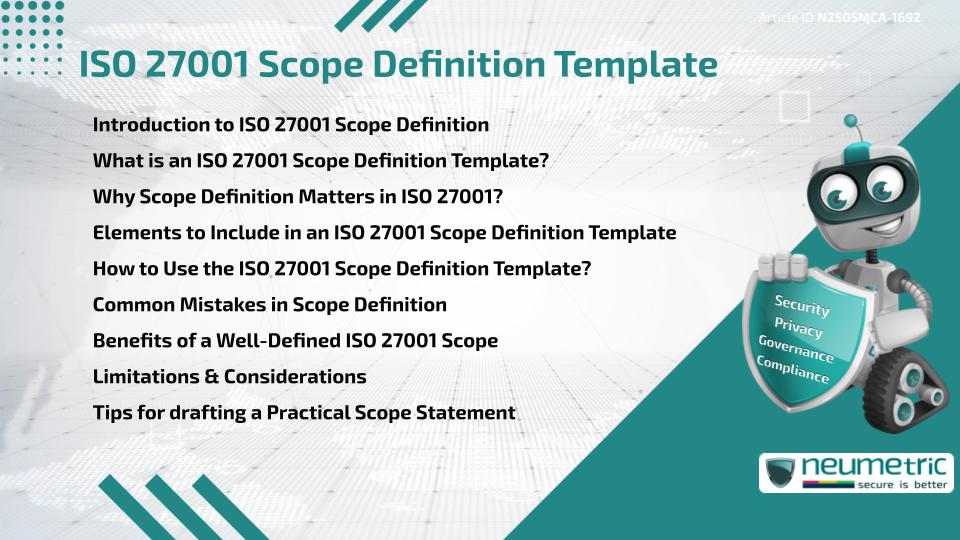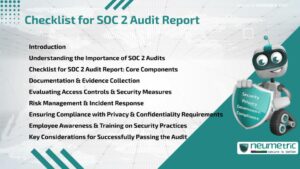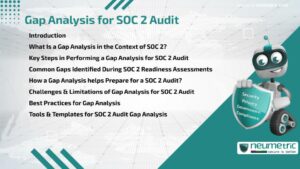Table of Contents
ToggleIntroduction to ISO 27001 Scope Definition
ISO 27001 is one of the most widely adopted standards for managing Information Security in Organisations. At the heart of this Framework is the concept of Scope Definition. But what exactly does that mean? How can an ISO 27001 Scope Definition Template be helpful?
In simple terms, Scope Definition in ISO 27001 refers to setting the boundaries for your Information Security Management System [ISMS]. Without a clear scope, your security efforts can become Scattered, Ineffective or Non-Compliant. This article explores how to define this scope effectively using a structured & repeatable Template.
What is an ISO 27001 Scope Definition Template?
An ISO 27001 Scope definition Template is a structured format used by Organisations to define what parts of the Business are covered by their ISMS. It typically includes Location, Assets, Technologies, Departments & even Legal or Regulatory Boundaries.
The Template outlines where your security program starts & stops. It prevents confusion & ensures everyone—from Auditors to IT Staff—understands what is in scope & what is not.
Why Scope Definition Matters in ISO 27001?
A well-defined scope ensures efforts are focused where they have the greatest impact. Without it, you risk spending Resources on unnecessary Controls or missing Critical Systems.
It also supports Compliance. During Audits, unclear scope statements often result in Delays or Non-Conformities. A defined scope avoids ambiguity & ensures consistency across Documentation.
Lastly, it boosts Stakeholder confidence. Whether you are working with Partners, Clients or Regulators, a concise scope shows that you know exactly what you are protecting.
Elements to Include in an ISO 27001 Scope Definition Template
Your ISO 27001 Scope definition Template should include several important elements:
- Organisational Boundaries – which Departments, Functions or Teams are involved.
- Physical Locations – Offices, Data Centers or Remote facilities.
- Technological Assets – Servers, Cloud Services or Apps.
- Legal & Regulatory constraints – if Compliance needs differ by Geography.
- Interface with Third Parties – Outsourced Vendors or External Users.
These elements help create a full picture.
How to Use the ISO 27001 Scope Definition Template?
Start with brainstorming sessions involving key Stakeholders. Use the Template as a Worksheet, filling in details about each Department, Location or Asset.
Then validate the Scope. Are you including Systems that no longer matter? Are you excluding areas that pose High Risk?
Refining the Template can be an ongoing task. Revisit it during Internal Audits or after major Business Changes.
Common Mistakes in Scope Definition
Many Organisations make avoidable mistakes when using an ISO 27001 Scope definition Template. Some of the most common include:
- Being too broad – leading to unnecessary Effort & Resource drain.
- Being too narrow – excluding Systems that should be protected.
- Ignoring Remote Work Environments – a rising concern post-2020.
- Using vague language – like “all IT Systems” without specifics.
These mistakes often stem from rushing the process or failing to involve the Right Teams.
Benefits of a Well-Defined ISO 27001 Scope
A strong scope statement brings clarity, control & confidence. Some of the biggest advantages include:
- Focused Risk Assessments
- Streamlined Control selection
- Improved Audit readiness
- Better Resource allocation
You will not waste time on Systems that do not matter or overlook those that do.
Limitations & Considerations
While a Scope Definition Template is incredibly helpful, it has its limits. It can not capture all organisational nuances. It also needs regular updates to stay relevant.
Smaller Businesses may find that Pre-made Templates are too general. Larger Enterprises might need several versions tailored to different regions or units.
Balance is key. The Template should guide, not dictate your decisions.
Tips for drafting a Practical Scope Statement
Drafting your first ISO 27001 Scope Statement can seem daunting. Here are some practical tips:
- Use plain language—not security jargon.
- Align scope with Business Objectives.
- Involve Legal & Compliance Teams early.
- Include exclusions, if any, with clear justifications.
- Review annually or after major organisational changes.
You do not need to perfect it on day one. Start simple, then refine as you go.
Takeaways
- An ISO 27001 Scope definition Template helps outline the boundaries of your ISMS.
- A clear scope improves Audit readiness, Resource allocation & Stakeholder confidence.
- Avoid vague, over-broad or outdated definitions.
- Regularly review & update your scope to match organisational changes.
- Use the Template as a Tool, not a Rulebook.
FAQ
What should be included in an ISO 27001 Scope definition Template?
It should include Organisational Boundaries, Locations, Assets, Technologies, Third Party Relationships & applicable Regulations.
Can I exclude Departments or Assets from the ISO 27001 Scope?
Yes, but you must clearly explain why they are excluded & ensure it does not create Security Gaps.
Is the ISO 27001 Scope definition Template mandatory?
While the use of a Template is not mandatory, having a structured format is strongly recommended for consistency & Audit clarity.
How often should I update my ISO 27001 Scope definition?
At least once a year or whenever there is a major change in Business Operations, Locations or Technology use.
What happens if my scope is too broad?
You may waste Resources & complicate Audits by including Systems that do not need to be in Scope.
Can Small Businesses use an ISO 27001 Scope definition Template?
Yes & it is especially helpful for simplifying the Compliance process in small Organisations.
Who is responsible for defining the ISO 27001 Scope?
Typically, Senior Management & the ISMS Lead collaborate, with input from IT, Legal & Compliance.
Where can I find a good ISO 27001 Scope definition Template?
Resources are available from non-commercial sources like ISO.org or Cybersecurity Blogs that guide ISO Implementation.
Need help?
Neumetric provides organisations the necessary help to achieve their Cybersecurity, Compliance, Governance, Privacy, Certifications & Pentesting goals.
Organisations & Businesses, specifically those which provide SaaS & AI Solutions, usually need a Cybersecurity Partner for meeting & maintaining the ongoing Security & Privacy needs & requirements of their Clients & Customers.
SOC 2, ISO 27001, ISO 42001, NIST, HIPAA, HECVAT, EU GDPR are some of the Frameworks that are served by Fusion – a centralised, automated, AI-enabled SaaS Solution created & managed by Neumetric.
Reach out to us!





